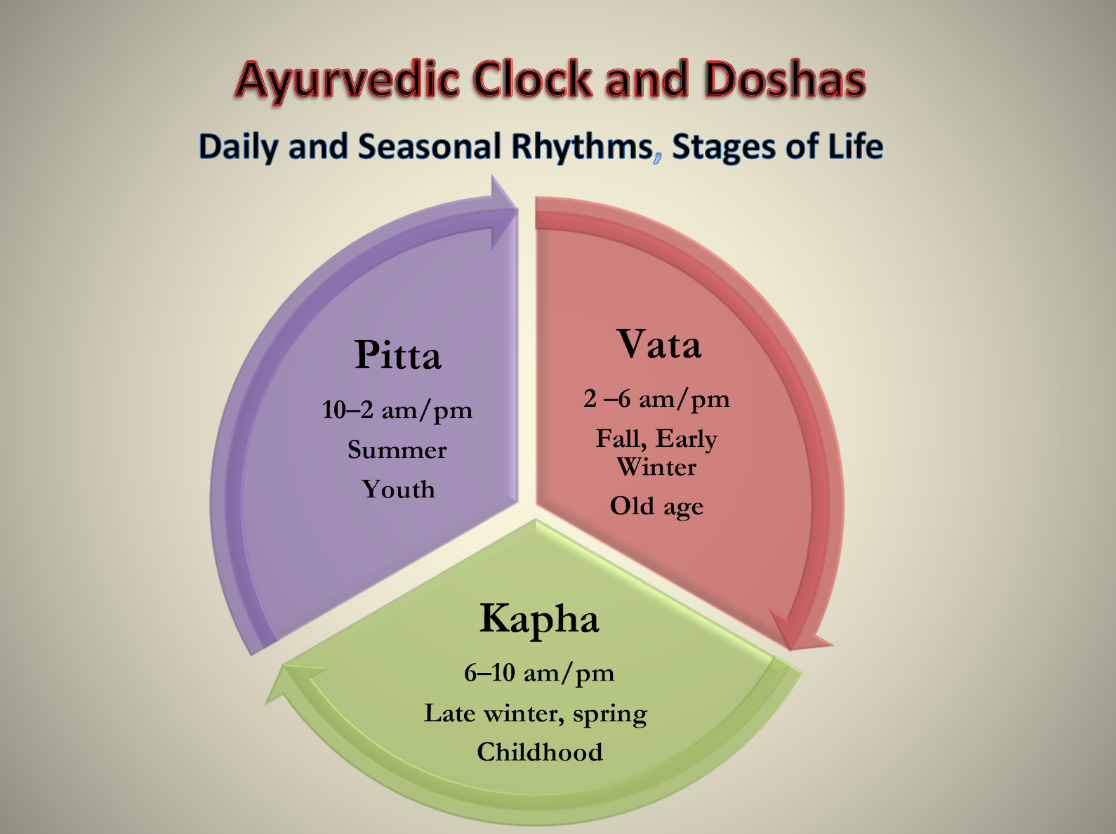Art of Living Founder Gurudev Sri Sri Ravi Shankar relates a story about how Sages approached Lord Vishnu to tell him that people were still falling sick though he, incarnated as Lord Dhanvanthari, gave them the means to cure illnesses through Ayurveda. They needed help, not merely with physical illnesses, but mental and emotional illnesses. Lord Vishnu was lying on a bed of snakes; the serpent Adishésha with a thousand heads which is a symbol of awareness. He blessed them and Adishésha was born in the world as Maharishi Patanjali to propagate the knowledge of yoga.
A Brief History of Yoga and Ayurveda in the West
This story illustrates how beautifully Ayurveda and yoga together address holistic health. The very definition of health is Swasthya, or to be ‘established in the self.’ We know yoga is not just about complex physical postures—or asanas—and Ayurveda is not merely about herbs and khichdi cleanses. These Vedic sciences originated in India over 5,000 years ago to preserve health and raise consciousness. Yoga provides support to the mind and spirit through practices like breathwork and meditation. Ayurveda is a natural, holistic ‘science of life,’ one of the most ancient forms of medicine that is personalized, preventive, and has robust disease management protocols.
Swami Vivekananda and Paramhansa Yogananda introduced yoga to the West in the 19th century. Its transmission was easier, as a daily practice of immigrants. Later, it became focused on physical fitness and asanas. However, people today are increasingly reverting to yoga’s original, pure intent for healing and practice with appreciation, not appropriation. Studying lineage traditions such as Sri Sri Yoga and embracing all eight limbs has become more important than new-age interpretations like hot yoga and aerobic pretzel-like postures irrespective of body type and fitness.
Invaders burnt down Vedic libraries like Nalanda and British colonizers banned the practice and teachings of Ayurveda in 1833. Lineages were broken and knowledge lost, but practitioners provided access to Ayurveda in many villages and Southern India. Ayurveda revived, and greater emphasis was placed on standardization and quality control after India’s independence in 1947. Ayurveda, as a clinical practice, followed yoga to the West almost a hundred years later with Dr Vasant Lad, Deepak Chopra, and Gurudev Sri Sri Ravi Shankar. Today, it is a form of medicine in India and a complementary healing science in the US.
In the words of Dr. David Frawley, esteemed Vedic scholar and director of the American Institute of Vedic Studies, “Using Ayurveda along with Yoga helps us gain complete harmony and balance in body and mind so that we can discover our true Self that is one with all. All Yoga teachers should learn the fundamentals of Ayurveda and all Yoga students should seek Ayurvedic guidance to enhance their Yoga practice”.
Ayurveda to Optimize Yoga Practice and Teaching
Yoga is an invaluable therapeutic tool in Ayurvedic practice. Yoga teachers learn the fundamentals of Ayurveda to aid their daily practice and make a comprehensive offering to their students.
Here’s how Ayurveda can enhance yoga practice:
- The Guna’s—Orientations of the Mind
Ayurveda and yoga both talk about the orientations of the mind.
- Sattva (the clear, pure, balanced, natural state)
- Rajas (ambition and restlessness)
- Tamas (dullness and lethargy)
The Guna’s change constantly; and, as Gurudev Sri Sri Ravi Shankar says, we need all of them. We need Rajas to wake up and Tamas to sleep—being a witness to these changes helps. Enhancing Sattva through meditation, a light diet, adequate sleep, and a healthy lifestyle helps manage mental disorders and enhances overall holistic health and immunity.
- Incorporating Doshas, Constitution, and Imbalances
Ayurveda helps you understand your constitution and imbalances, as well as that of your clients. Panchamahabhutas (five great elements) combine to form doshas—energy principles.
- Vata (ether and air) is the principle of movement
- Pitta (fire and water) is the principle of transformation.
- Kapha (water and earth) is the principle of cohesion
Prakriti, or body constitution, is formed at conception as a combination of doshas (V, P, K, VP, VK, PK, or VPK); that remains unchanged. This governs our structure, function, affinities, and tendencies. For instance, a typical Pitta is “My way or the highway.” Vikriti, or imbalances, occur when doshas go out of balance. An important aspect of Ayurvedic assessment and management of imbalances is understanding the Agni, digestive and metabolic fire which yoga helps stabilize.
A typical vata is likely to have a creative idea for a startup, pitta would lead it successfully, and kapha would maintain it and keep it going.
A knowledge of doshas helps us formulate routine, dietary, and lifestyle guidelines to support our health and that of our clients. Personalizing yoga guidelines helps with the unique constitution of clients, their imbalances and chronic ailments, and working with indications and contraindications of various practices.
Consult an Ayurvedic practitioner before taking any herbs and formulations. In a state of health, this is how we can adapt practices for various doshas.
Vata Dosha and Yoga Recommendations
-
- Qualities Dry, cold, rough, light, clear, mobile, and subtle.
- Traits Vata is petite, agile, creative, compassionate, good-natured, changeable, impulsive, inconsistent, enthusiastic, good at multitasking, quick at learning and forgetting, with variable appetite.
- Imbalances Joint disorders, sensitivity to diet and weather—particularly cold weather; fluctuating Agni, issues with circulation and joint disorders, dry skin and hair, bloating, constipation, insomnia, anxiety, and restlessness.
- Yoga Recommendations
- Slow, regular, grounding, restorative Yoga
- At less than capacity, with breaks
- Floor sequences, stabilizing, grounding, and balancing poses like vrksasana (tree pose), virabhadrasana (warrior poses), tadasana (mountain pose), Padmasadhana sequence, Pawanmuktasana (wind releasing pose), forward and backward bends, twisting to kindle Agni.
- Longer Shavasana.
- Focus on calming the CNS, strengthening the lower spinal region, pelvic floor, and colon which are the seat of Vata, stimulating the parasympathetic nervous system.
- Pranayama
- Abdominal breathing, alternate nostril breathing, Brahmari (bee breath), Ujjayi (ocean or victory breath), and full yogic breathing.
- Calming but heating breathwork is good. Avoid very stimulating breathwork.
- Meditation Vata can lead to a lack of focus and restlessness. Guided meditation, mantra meditation, and chanting mantras help. Yoga to settle Rajas and breathwork for grounding before meditating can deepen your practice.
- Diet, lifestyle, and Herbal Recommendations
- Follow a routine and get enough sleep.
- Have warm, cooked, unctuous food with sweet, sour, and salty tastes. Favor whole grains, dairy (including ghee), lentils, nuts and seeds, grounding veggies like root vegetables; sweet potatoes, carrots, okra, the squash family; sweet and citric fruits, soups and stews, and heating spices.
- Avoid raw, cold, dry foods, and cruciferous veggies, and reduce caffeine and stimulants.
- Stay hydrated.
- Don’t over-exercise; nature walks and breaks are helpful.
- Try a daily Abhyanga or self-massage.
- Herbs like ginger, Ashwagandha, licorice, Rasna, and Haritaki help balance Vata.
Pitta Dosha and Yoga Recommendations
-
- Qualities Hot, light, sharp, oily, liquid, acidic, and spreading.
- Traits A typical Pitta is intellectual, fiery, motivated, goal-oriented, and a good leader. They also have healthy digestion, circulation, and metabolism.
- Imbalances Inflammation, hyperacidity, skin disorders, early balding, graying and thinning of hair, sensitivity to hot weather, excess hunger, and thirst, burning sensations, insomnia, impatience, a tendency to get ‘hangry’ (angry when hungry), aggression and irritability.
- Yoga Recommendations
-
-
- Meditative, slow yoga.
- Gentle movements with spinal twists (take care during backbends or spinal compression poses) and forward bends.
- Focus on the navel and solar plexus with asanas like bhujangasana (cobra), dhanurasana (bow), matsyasana (fish) and Ardhamatsyendra asana (seated spinal twist).
- Sequences like sun salutations done mindfully and slowly.
- May be drawn to intense practices like Ashtanga, or “hot yoga”, but try to avoid them, and avoid being competitive or seeking perfection.
-
- Preferably done before sunrise or in the morning; avoid practicing when it is very hot.
- Longer shavasana.
- Focus on cooling down, relaxing, and calming the system.
- Pranayama
- Alternate nostril breathing, Shitali, Shitkari, Brahmari and full yogic breathing are all good for Pitta.
- Avoid heating Pranayama.
- Meditation – Pitta may be impatient and seek perfection. Compassion, loving-kindness meditation, chakra meditation, and cooling imagery help pacify Pitta.
- Diet, Lifestyle, and Herbal Recommendations
- Slow down and cool down.
- Avoid intense exercise.
- Avoid heat and exercising in the heat.
- Reduce oily, hot, salty, fermented, and spicy food and favor sweet, astringent, and bitter foods. Incorporate dairy (including milk and ghee if tolerated well), sweet fruits, greens, lentils, legumes, and whole grains.
- Have a regular practice of meditation and be mindful about being too competitive.
- Herbs like coriander, Amla, Amruth (Guduchi), Brahmi, and Shatavari help balance pitta.
Kapha Dosha and Yoga Recommendations
- Qualities Moist, cold, sticky, heavy, slow, smooth, soft, stable and cloudy.
-
- Traits Grounded, strong, nurturing, supportive, steady, empathetic, with rounded, flexible joints, smooth, oily skin and hair, good health, stamina, and immunity.
- Imbalances Slower metabolism, a tendency to gain weight and oversleep, stagnation, congestion, sinusitis, edema, metabolic disorders, resistance to change, lethargy, and depression.
- Yoga Recommendations
- Energetic, active yoga.
- Switch around the routine.
- Warmer and faster class.
- Stimulate respiration and induce sweating.
- Sequences like sun salutation practiced with vigor, standing asanas like Virabhadrasana or warrior pose, Trikonasana or Triangle Pose, forward and backbends like Paschimottanasana or forward fold and Setu Bandhasana or bridge pose, inversions, and those that stimulate the lungs and improve circulation are good for Kapha.
- Stimulate Agni and avoid stagnation by revving up the system.
- Pranayama
-
-
- Kalapbhati (shining skull), Ujjayi (victory breath), Bhastrika (bellows breath), Surya Bhedana followed by alternate nostril
- Heating, stimulating breathwork
- Meditation Kapha tends to lean toward lethargy, slower digestion, and tamas. Active yoga before meditation helps. Satsang and singing can also help balance kapha.
-
- Diet, Lifestyle, and Herbal Recommendations
-
- Spice things up and stay active!
- Stay warm.
- More intense exercise.
- Favor bitter, pungent, and astringent food—all heating and pungent spices are good! Legumes, veggies, and grilled and sautéed foods with less oil and dairy are helpful.
- Avoid sweets, salty, heavy, and oily food.
- Avoid overeating.
- Avoid daytime sleep and sleeping too much.
- Herbs like tulsi, ginger, turmeric, black pepper, trikatu, Guggulu, and triphala help balance kapha.
Adapting Yoga to Natural Rhythms
The Ayurvedic clock syncs time periods with functional energies and gives us an idea about how to optimize diet, sleep, nutrition, and yoga practice. Everything in nature—humans, animals, plants, seasons, times of day, and stages of life—are dominated by doshas. Aligning with nature, circadian rhythms, and seasonal cycles, is a powerful means to adapt yoga for restoring health. The figure depicts the Ayurvedic Clock in the US.

- Daily Routine or Dinacharya Sleep early by around 10 pm and try and wake early, before 6 am. The optimal time for Yoga is 4-6 am or Brahmamuhurat. Wait at least an hour after a meal to practice. Some of this is intuitive, for instance, it is better for Pitta folks not to practice Yoga during Pitta hours in the summer as it can be heating. Similarly, a slower, restorative practice is better in the evening to enhance sleep quality.
- Seasonal Routine or Ritucharya Follow the Dosha suggestions for various seasons; for instance, follow Kapha yoga suggestions during late winter and spring unless there is an overriding imbalance. Try heating, stimulating pranayama like kapal bhati and active yoga sequences.
- Stages of Life Kapha dominates during childhood, pitta during youth, and vata in old age. More people are living longer and enhancing the quality of longevity is paramount. Reducing stress, improving immunity, and honoring the stage of life in yoga practice helps prevent degenerative diseases. Staying flexible and supple helps avoid injuries.
- Applications for Imbalances
All eight limbs of yoga have therapeutic benefits that can be used in Ayurvedic applications, with prevention and disease management. For instance, for someone with constipation, anxiety, and joint pains, a likely vata imbalance would necessitate advising a vata-pacifying Ayurvedic regimen and yoga. Similarly, meditation is ideal for someone with Ulcerative Colitis. Hot, midday yoga and heating asanas like sun salutations or stimulating breathwork like Bhastrika should be avoided. A customized routine would involve slower, meditative yoga; breathwork like alternate-nostril breathing; lowering stress; avoiding late nights; reducing processed, sour, and spicy foods; and incorporating personalized formulations.
- Customizing Yoga Classes and Adding Ayurvedic Offerings
“The end of our ever-expanding space is unknown even to the divine,
Just as the worth of gifting health and healing is limitless for humankind.”
—Skandapurāna
Yoga can be adapted in one-on-one sessions or themed classes based on doshas, gunas, age groups, time of day, and seasonal variations. In group classes, you can customize suggestions and prompts based on different constitutions and stress contraindications for imbalances. These modifications can be made as you observe and assist various clients. Pranayama can improve digestion and metabolism or restore calm; asanas and sequences like Padmasadhana can strengthen and ground the body, and be meditative or active. Every client has unique needs and you could adapt their practice over time and through stages of their healing journey.
Add topics like nutrition, daily rituals, and lifestyle suggestions based on Ayurvedic guidelines to your offerings. Classes can be enhanced with Ayurvedic specialty workshops which can help you grow your clientele, build a robust practice, and carve out a specialty niche!
- Self-Care
“Sama Dosha, Sama Agni, Sama Dhatu, Malakriyah
Prasanna Atmaindirya Manaha Swastha iti Abhidheyate”
- Susruta Samhita 24/41
The Ayurvedic definition of health is to have a balanced state of doshas, dhatus (tissues), Agni (digestive and metabolic fire), malas (proper elimination), a pleasant and peaceful Atma (soul), Indriya (senses), and Manaha (mind).
Any healer needs to wear their oxygen mask first and self-care is of paramount importance. Take care of your health and well-being comprehensively and holistically with the gifts of Ayurveda and yoga. In the words of Gurudev Sri Sri Ravi Shankar, “The practice of Ayurveda can truly enhance your quality of life.”
Disclaimer This content is not intended to be a substitute for professional medical advice, diagnosis, or treatment or Ayurveda advice, assessment, or management. Always seek the advice of your physician or other qualified health providers with any questions you may have regarding a medical condition and seek the advice of your Ayurvedic practitioner for any disease management related queries using the Ayurvedic process. Any links to third-party websites are provided as a convenience only and neither the author nor Sri Sri School of Yoga is responsible for their content.
About the Author: Anuradha Gupta, Ayurvedic Doctor, YT-200, MBA, is a NAMACB-certified Ayurvedic Practitioner, meditator, writer, and engineer. She writes for Art of Living, Art of Living Retreat Center and Kerala Ayurveda, USA and has co-authored a book on Ayurveda, Unveiling Health, Happiness and Longevity: A Primer on Ayurveda: Pandya, Ashish, Gupta, Anuradha: 9798329189360: Amazon.com: Books. She volunteers for the Art of Living Foundation, Project Welcome Home Troops, PFLAG and other non-profits. You can find her on Facebook, and LinkedIn.
(It is not necessary to give the book title, please feel free to exclude it)

